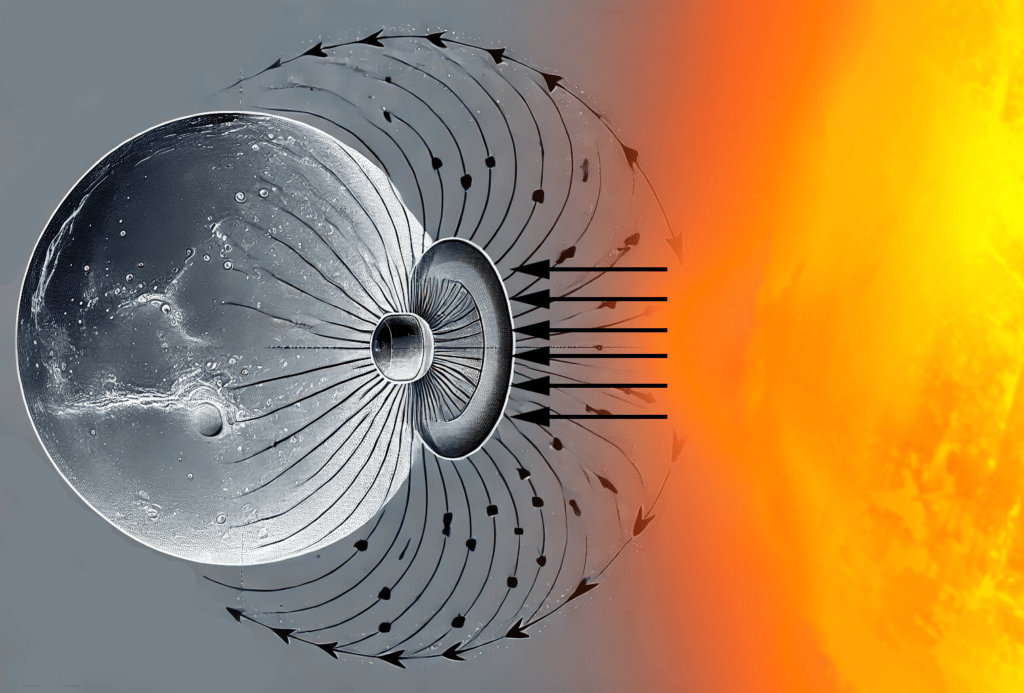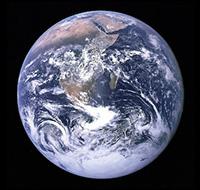In the grand vision of humanity’s future beyond Earth, one of the most ambitious challenges is the terraforming of Mars. To transform the red planet into a new world for human civilization would not only represent a monumental scientific achievement but would also redefine our relationship with the cosmos. Independent researcher Geo Douglas from New Jersey has proposed a potential new approach in his paper, “Terraforming Mars by Creating Dayside Magnetic Reconnection Events at the Mars-Sun L1 Point.” His concept presents an innovative method for accelerating the transformation of Mars into a habitable environment.
Douglas’ approach revolves around creating an artificial magnetic field at the Mars-Sun L1 point, a stable location where the gravitational forces of Mars and the Sun balance. By deploying a series of satellites equipped with magnetic field generators at this precise location, Douglas proposes triggering magnetic reconnection events. These events would convert the solar wind into heated magnetized plasma, releasing substantial amounts of kinetic, thermal, and electromagnetic energy that would be directed towards the surface of Mars. According to Douglas, this continuous influx of energy could build the Martian atmosphere, increase greenhouse gas accumulation, and even warm the planet to partially melt the polar ice caps, potentially accelerating the planet’s revitalization process in only a few decades. This approach stands in stark contrast to most other proposed methods for terraforming Mars, which typically require hundreds or even thousands of years to achieve significant changes.
To understand magnetic reconnection, we need to examine the most energetic regions in our solar system. While it might seem logical to assume that the most energetic region is near the Sun, this isn’t the case. The solar wind is a stream of charged particles ejected from the Sun’s corona. It does lose some energy as it travels through space, primarily due to expansion that reduces its density and pressure, however it retains a substantial amount of energy even as it reaches distant planetary environments.
So where are the most energetic regions in our solar system? To answer this, we need to look at how the solar wind, traveling at speeds over two million miles per hour, reacts as it approaches a planet’s magnetosphere, such as Earth’s. As the solar wind hits our magnetic field, field lines from different directions break and reconnect, releasing a burst of stored magnetic energy. This process converts magnetic energy into kinetic, thermal, and electromagnetic forms, creating highly energetic plasma.

Among the fascinating outcomes of magnetic reconnection are plasma jets—streams of high-velocity plasma that carry significant kinetic energy. These jets form as a direct result of the reconnection process, propelling charged particles at extreme speeds. Simultaneously, twisted structures of magnetic field lines filled with high-energy plasma are called flux ropes, creating intense electric currents and concentrated regions of energy as the magnetic energy is converted into kinetic and thermal energy.
When these reconnected magnetic field lines snap back together, they generate a massive amount of energy that accelerates plasma particles, producing fast-moving ion and electron jets. The rapid movement and collisions of these particles generate thermal energy, raising plasma temperatures. On Earth, these magnetic reconnection events are so powerful, they create phenomena that can be seen with the naked eye such as the Aurora Borealis and Australis (the Northern and Southern Lights), where charged particles collide with the upper atmosphere, creating stunning light displays.
Despite the immense energy of Earth’s magnetic reconnection events, they are not the most energetic in our solar system. That distinction belongs to Jupiter’s magnetic reconnection region. This highlights an important fact… the energy produced by magnetic reconnection is not solely dependent on distance from the Sun, but is significantly influenced by the strength of the planet’s magnetic field. Jupiter, the largest planet in the solar system, has a magnetic field approximately 20,000 times stronger than Earth’s, resulting in far more energetic reconnection events. Consequently, aside from transient events like solar flares, Jupiter’s magnetic reconnection region is the most energetic area in our solar system, followed by Saturn’s magnetic environment, with Earth’s events ranking third.
The uniqueness of this proposal lies in its focus on leveraging natural solar phenomena in a controlled, targeted manner directed straight to the surface of Mars. Unlike traditional terraforming ideas that rely on immense, long-term efforts such as mirror satellites or introducing photosynthetic organisms, Douglas’ method offers a dynamic and immediate mechanism to accelerate atmospheric development and a heating effect of the planet. The creation of an artificial magnetic field at the Mars-Sun L1 point would trigger magnetic reconnection events, directing an equivalent of 100 atomic bombs of energy to the planet’s surface over a 25 year span.
To accomplish this, the paper outlines the deployment of a series of satellites equipped with advanced magnetohydrodynamic (MHD) generators to be used to create a magnetic field that interacts with the incoming solar wind, therefore triggering magnetic reconnection events. The generated magnetized plasma would then flow toward Mars, carrying kinetic and thermal energy to the planet’s surface, warming it, releasing trapped gases like CO₂ and H₂O, and potentially initiating or enhancing geological activity.
The concept hinges on the strategic placement of a magnetic field at the Mars-Sun L1 point, a position that is approximately 1.5 million kilometers from Mars. Despite this vast distance, Douglas explains that a relatively small magnetic field, only a 1.5 miles in radius, would suffice to trigger the desired effects, due to the unique geometric relationship between this point and Mars. This efficiency is a key strength of the proposal, as it allows for maximum impact with minimal resources to create a continuous and controlled terraforming effect.
Douglas further details how the energy generated by magnetic reconnection events would not only increase atmospheric temperature but also enhance the density and stability of the Martian atmosphere over time. This mechanism could trigger a self-sustaining cycle of atmospheric building, wherein the warming atmosphere releases more greenhouse gases, thickening it further and raising surface temperatures to levels more conducive to supporting liquid water. The kinetic energy from plasma impacts could also help to break up the Martian regolith, potentially releasing subsurface water and volatiles.
Furthermore, Mars’ surface is primarily covered with basaltic rocks, rich in iron, magnesium, and silica, similar to those on Earth. These volcanic rocks have a high heat capacity, allowing them to absorb and retain heat during the day and distribute it slowly over time. As Mars rotation is nearly similar to Earth’s 24 hour days, creating a more stable and warmer surface environment even at night is of vital importance.
When heated, basaltic rocks can release trapped volatiles like water vapor, carbon dioxide, and sulfur dioxide, contributing to the atmosphere. Focusing thermal energy from magnetic reconnection events on these regions could enhance soil properties for future biological processes and create a more sustainable environment as the hot plasma would likely reduce wind storms.
As Mars becomes more hospitable through the proposed terraforming process, creating a larger artificial magnetic field will become increasingly essential. In other terms, while the initial magnetic field generated at the Mars-Sun L1 point will aid in terraforming the planet, eventually we must expand this field to direct the magnetic reconnection effects to go around the planet, instead of the initial direct contact. This magnetic field will also block dangerous radiation and block the solar wind from hitting the planet directly and eroding its atmosphere as it is currently doing. This is one of the most important factors of Douglas’ proposal, that if we want to make Mars a habitable planet, we must generate a magnetic field at the Mars-Sun L1 point anyway. Therefore, initiating the creation of an artificial magnetic field now not only supports immediate terraforming goals, but also lays the foundation for human protection and sustainability, ensuring that Mars will be ready to safely support human life as it transforms into a habitable planet.

Douglas’ paper does not shy away from the complexities and challenges involved in its implementation. The paper acknowledges the technical and logistical hurdles of deploying and maintaining a network of satellites at the Mars-Sun L1 point, generating a stable magnetic field with substantial strength, and managing the energy dynamics of the reconnection events. Furthermore, Douglas emphasizes the need for international collaboration, sustained funding, and continued innovation in space technologies to bring this vision to fruition.
While bold and ambitious, Douglas’s proposal offers a transformative vision for Mars’ future that compliments visionaries such as Elon Musk who challenges the established norms and encourages a new era of space exploration. It invites us to think beyond traditional terraforming concepts and consider dynamic, innovative approaches that leverage our growing understanding of planetary science and space physics. This paper stands as an inspiring reminder that humanity’s path to becoming a multi-planetary species may not be as distant or as daunting as we once thought—as long as we are willing to embrace innovation and overcome obstacles.
By combining scientific rigor with imaginative speculation, Geo Douglas presents a compelling case for accelerating the terraforming of Mars by utilizing the power and capabilities of our home star. His paper challenges us to explore new frontiers, harness natural cosmic phenomena in novel ways, and consider the transformative potential of emerging technologies. Ultimately, this proposal is more than just a scientific concept, it is a call to action for humanity to seize the opportunity and create a new future on the red planet for mankind.
Link to paper: https://www.researchgate.net/






